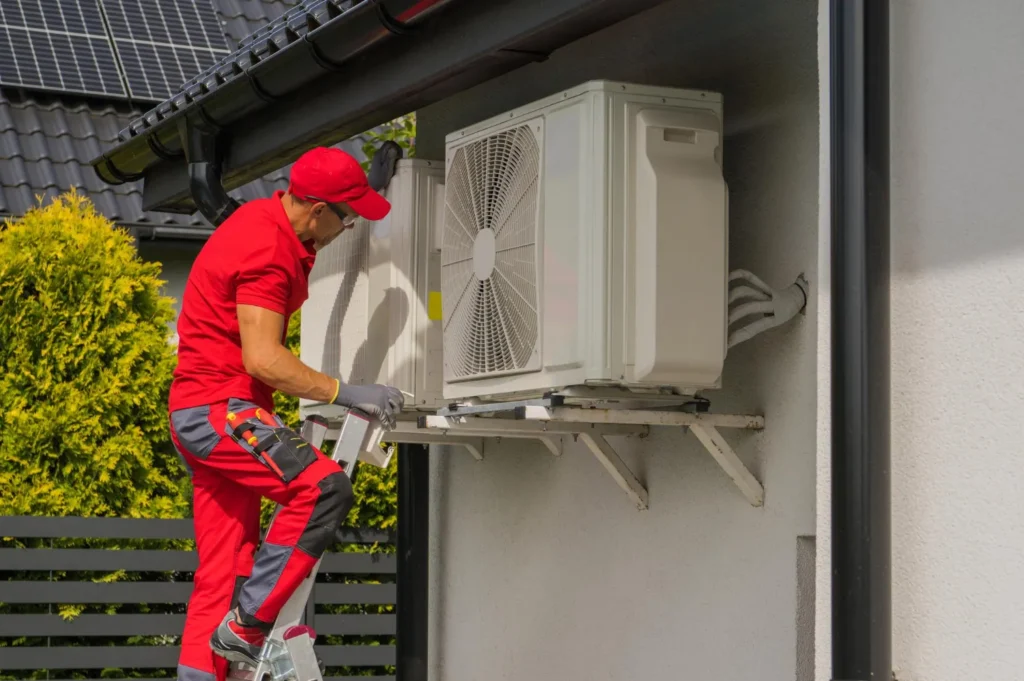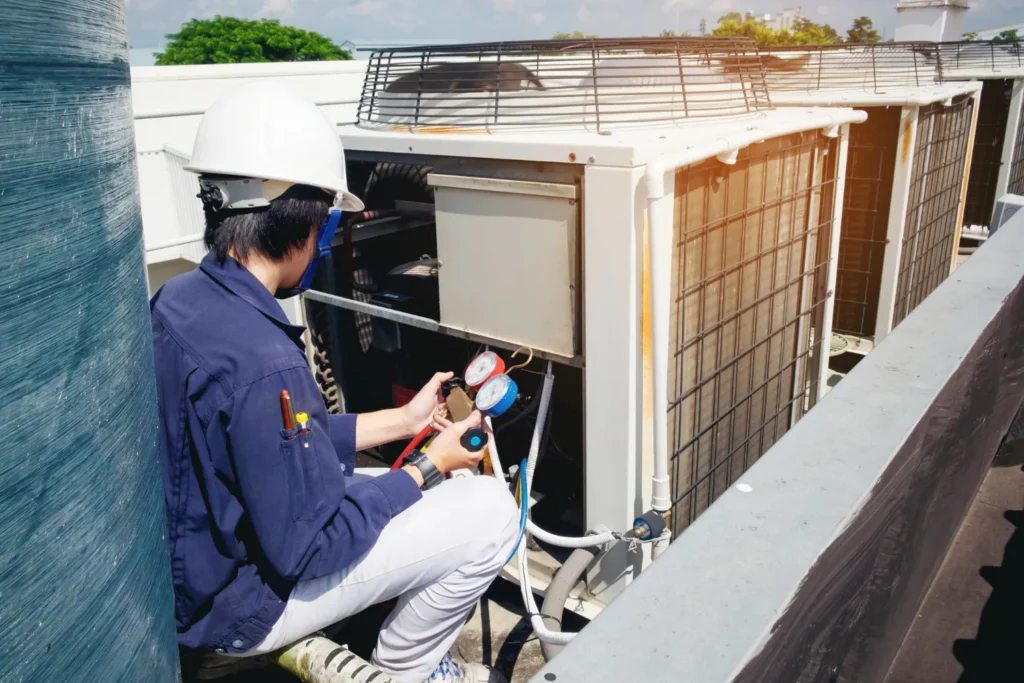Feeling a bit uneasy about your AC’s performance? You’re not alone. Your cooling system might be trying to tell you something, and it’s crucial to understand its language. In this guide, we’re diving deep into the world of AC SOS: 10 Powerhouse Signs Your AC Needs Repair! From subtle hints to glaring red flags, we’ll decode the messages your AC is sending and empower you to take action before it’s too late. So, grab a seat and get ready to uncover the secrets your AC has been keeping.
Table of Contents
ToggleImportance of Maintaining a Functioning AC System

Maintaining a functioning AC system is crucial for several reasons, primarily comfort, cost efficiency, and health. First and foremost, an efficient AC system ensures that your home or business maintains a consistent and comfortable temperature, regardless of the external weather conditions. This comfort is not just about feeling good but also about keeping an environment conducive to productivity and relaxation.
From a cost perspective, a well-maintained AC system operates more efficiently. This efficiency translates into lower energy consumption, which directly impacts your energy bills. For instance, an AC system struggling due to a clogged air filter or leaking refrigerant will have to work harder to cool the same area, using more energy and thus increasing costs.
Moreover, the health implications of a poorly maintained AC system are significant. An AC system that is not functioning correctly can circulate dust, pollen, and other allergens within your home or office. Additionally, issues like mold growth in the ductwork or a malfunctioning evaporator coil can compromise air quality, potentially leading to respiratory problems and other health issues for the inhabitants.
Understanding Your AC’s Normal Operation
To effectively determine signs your AC needs repair, it’s essential to understand its normal operational characteristics. A typical residential or commercial AC system is engineered to provide:
- Consistent Cooled Air Output: Delivers a steady flow of cool air throughout the cycle.
- Controlled Humidity Levels: Maintains humidity within a comfortable range, essential for both comfort and to prevent mold growth.
- Quiet Operation: Operates with minimal noise, usually a soft hum during its cooling cycles.
Key Components of an AC System
- Compressor: The heart of the system, responsible for moving the refrigerant throughout the system. Usually, it should emit only a steady, humming sound when active.
- Condenser: Works to expel heat taken from the indoor air to the outside environment.
- Evaporator: Absorbs heat from the indoor air, effectively cooling it.
- Expansion Valve: Regulates the flow of refrigerant, ensuring efficient cooling operations.
Operational Norms to Monitor:
- Sound: The compressor should not produce loud bangs or rattling noises. Such sounds coming can indicate mechanical issues.
- Air Temperature: Air from the vents should match the thermostat settings, providing consistent cooling as set.
- System Cycling: The AC should cycle on and off to maintain the desired temperature without overrunning. Continuous operation or frequent cycling might suggest inefficiency or a potential malfunction.
Understanding these components and their typical functions will help you quickly identify any signs that suggest your AC system might be experiencing issues. Keeping an eye on these signs will enable timely interventions, preventing more severe complications and ensuring optimal performance.
Explanation of How a Typical AC Unit Should Operate

The essential operation of an air conditioning (AC) unit is a fascinating process of evaporation and condensation, primarily driven by a substance known as refrigerant. Here’s a detailed breakdown of this cycle:
Start at the Evaporator Coil
- Location: Inside the house.
- Function: The refrigerant absorbs heat from the indoor air, causing it to evaporate.
- Result: The air cools and is then circulated back into the house.
- Moving to the Compressor:
- Process: The now heated refrigerant gas is compressed to a high pressure.
- Effect: This compression raises the refrigerant’s temperature significantly.
Next, the Condenser Coil
- Location: Usually outside the house.
- Function: The compressed, heated refrigerant releases the absorbed heat into the outdoor air.
- Result: The refrigerant cools down and returns to a liquid state.
Return to the Evaporator
- Cycle Completion: The cooled liquid refrigerant travels back to the evaporator to repeat the cycle.
Key Operational Norms to Monitor
- Smooth Cycling: The cycle should proceed smoothly, without interruptions or abnormalities.
- Noise: The system should operate without strange noises; unusual sounds can indicate mechanical problems.
- Airflow and Temperature Control: Airflow should be steady, and the temperature should correspond to thermostat settings.
- Warning Signs:
- Ineffective cooling.
- Ice formation on the coils.
- Any deviations in sound, airflow, or temperature control.
Monitoring these aspects of your AC’s operation can help you recognize early signs your AC needs repair, ensuring you address potential issues before they require significant ac repair service.
Early Warning Signs of AC Malfunctions
Early detection of potential AC malfunctions can save homeowners and business operators time and money. One of the first signs to look out for is unusual noises. An AC system should operate relatively quietly. Any sudden, loud, or unusual noises—such as grinding, squealing, rattling, or buzzing—can indicate mechanical issues. For instance, a grinding noise may suggest that the bearings in the blower motor are failing. At the same time, a buzzing sound could point to electrical problems.
Another telltale sign of AC troubles is inconsistent airflow and temperature fluctuations. If certain rooms or areas are cooling less efficiently, or if the AC no longer maintains the temperature set on the thermostat, it could signal issues such as blocked vents, duct leaks, or a failing compressor.
Additionally, an unexpected increase in energy bills can also indicate that your AC system is due for repair. Suppose your AC is consuming more power than usual. In that case, it is likely to work harder to maintain the desired temperatures, possibly due to issues like refrigerant leaks, dirty filters, or blocked ducts.
Also Read: Solving Common AC Problems: Expert Tips for Air Conditioner Issues
Physical Signs Your AC Is Struggling
Physical signs are often the most noticeable indicators that your AC system needs attention. One common physical sign is ice formation on the AC unit, particularly around the evaporator coil. This can occur if the airflow through the coil is restricted, usually due to a dirty air filter or low refrigerant levels.
Ice accumulation not only impedes the efficiency of your system but can cause significant damage if left unchecked. Addressing this early can prevent more severe complications like compressor failure, which is both disruptive and costly to repair.
Water leaks around the AC system are another significant physical sign of trouble. While it’s normal for your air conditioner to produce some condensation, excessive water leakage could indicate a clogged condensate drain line or a malfunctioning condensate pump. This can lead to water damage in your home and provide a breeding ground for mold and mildew, further impacting air quality and potentially leading to health issues.
Persistent humidity problems within your home or building can also suggest that your AC is not functioning correctly. A well-operating AC system should moderate humidity levels, maintain comfortable living conditions, and prevent the growth of mold. If you start noticing a sticky feeling in the air or if moisture is visible on windows and other surfaces inside your space, it might be time to call a professional to check your system.
Air Quality Issues Indicating AC Problems

The state of your AC system directly influences the quality of air inside your premises. One of the first signs of a problem is an increase in dust and allergens in the air. This could indicate that the air filters are either clogged or need replacement. Air filters are crucial as they trap dust, pollen, and other airborne particles. When these filters are not functioning correctly, it can lead to poor air quality, which can aggravate allergies and respiratory conditions.
Unpleasant odors emanating from AC vents are another indicator of issues. These smells could be caused by mold or mildew growth within the duct system or the AC unit itself, mainly if the system is not effectively dehumidifying the air. In some cases, a burning or electrical smell can indicate overheating components or wiring issues, which need immediate attention to prevent potential fire hazards.
Thermostat Problems That Signs Your Air Conditioner Needs Repair
The thermostat is the command center of your AC system, dictating how it operates. When there are inaccuracies in temperature control—such as the AC not cooling to the set temperature or overcooling—it can be a sign of a faulty thermostat. This might require recalibration or replacement of the thermostat.
Another issue to watch for is frequent cycling or the AC unit constantly running, which can be caused by thermostat problems. If the thermostat is not reading the room temperature accurately, it could cause the AC to turn on and off more frequently than necessary or to run continuously, both of which can strain the system and lead to premature wear.
The Role of Regular Maintenance in Preventing AC Repairs
Regular maintenance program is critical to ensuring the longevity and efficiency of your AC system. Changing air filters regularly, for instance, not only helps maintain air quality but also prevents the system from overworking, which can reduce its lifespan. Filters should ideally be changed every 30-90 days, depending on usage and the type of filter used.
Scheduled professional inspections can also help catch potential problems before they become significant issues. During these inspections, a technician will check all components of your system, including the compressor, condenser, evaporator, and thermostat, for signs of wear and tear. They will also ensure that the system has the correct amount of refrigerant, which is essential for efficient operation. Regular maintenance can help identify issues like minor leaks or wear on parts, which can be repaired more efficiently and cost-effectively than more significant problems.
How to Respond to These AC Repair Service Signs
When you notice signs that your AC may need repairs, it’s essential to assess whether it’s something you can handle yourself or if it requires professional intervention. Simple checks and fixes like replacing a dirty air filter or clearing debris around the outdoor unit can be done by most homeowners. However, for more complex issues such as refrigerant leaks, electrical problems, or comprehensive system checks, it’s advisable to call a professional.
Choosing the Right HVAC Professional for Repairs
When it comes to air conditioning repairs, choosing the right HVAC professional is as important as recognizing the signs that repairs are needed. You want to ensure that the technician who handles your system is qualified, experienced, and reliable. Look for professionals who are licensed and insured and who protect you in case of accidents or damage during the repair process.
It’s also advisable to check reviews and testimonials from other customers to gauge the quality of service provided. A reputable HVAC technician will have a solid track record of satisfied clients. Additionally, inquire about warranties and guarantees on the repair work. A confident and reliable technician will stand behind their work and offer assurances on the repairs conducted.
Conclusion – Signs Your AC Needs Repair
Recognizing the signs that your AC needs repairs and acting swiftly can make a significant difference in maintaining your system’s efficiency and longevity. From unusual noises and inconsistent airflow to physical signs like ice formation and water leaks, being vigilant about these indicators can save you from the discomfort and costs of a complete system breakdown.
FAQs About Signs Your AC Needs Repair
What are the most common signs that my air conditioner needs repairs?
Look for these key indicators: unusual noises (such as grinding or buzzing), inconsistent airflow or temperature fluctuations, ice formation on coils, and an unexpected increase in energy bills. These signs could indicate mechanical or electrical issues that require professional attention.
Why is my air conditioner making loud noises?
Loud noises like grinding or buzzing can signal serious issues within your AC unit. Grinding may suggest failing motor bearings while buzzing, which could point to electrical problems. It’s essential to have a professional technician diagnose and address these issues promptly.
How can I tell if my AC’s airflow is sufficient?
Insufficient airflow can be detected if certain rooms or areas feel warmer than others or the air from your vents isn’t as cold as expected. Possible causes include blocked vents, dirty filters, or duct leaks. Regular maintenance checks can help identify and resolve these airflow issues.
What might cause my air conditioning system to cycle frequently or operate continuously?
Frequent cycling or continuous operation of your AC unit can be caused by various factors, including incorrect thermostat settings, an AC unit that is improperly sized for your space, or other underlying issues such as a malfunctioning thermostat or leaking refrigerant. Professional evaluation is necessary to pinpoint the exact cause and determine the appropriate solution.
How can regular maintenance reduce my air conditioning repair service needs?
Regular maintenance ensures that your air conditioning system operates efficiently and helps prevent minor issues from escalating into major problems. Routine inspections typically include tasks such as cleaning filters, checking and refilling refrigerant levels, inspecting electrical connections, and ensuring the evaporator and condenser coils are clean and functioning correctly. These preventive measures can significantly extend the lifespan of your AC unit and enhance its performance, ultimately reducing the need for repairs.
